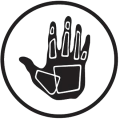The Hawaiian Monk Seal- Protecting Hawaii’s Official State Mammal
Cute as puppies, Hawaiian monk seals always cause delight when spotted sun bathing on the beach or the lava rocks along the Kona coast. Most seal species make their home in the cold waters of the Antarctic and on northern shores. The Hawaiian monk seal is a rare exception. Around the world, warm-water monk seals are struggling to survive. In fact, the Caribbean monk seal, a close relative to the Hawaiian monk seal, was listed as extinct in the 1970s. The Hawaiian monk seal is named for the folds of skin that resemble a monk’s cowl. The Hawaiian name for the seal is `Ilio holo I ka uaua, meaning, ‘dog that runs in rough water.’
Monk seals spend most of their time at sea, and come ashore to lounge on the beach or seek vegetative shelter from storms. They prefer the remote Hawaiian islands and atolls in the northwest that are generally uninhabited by humans and make excellent feeding grounds with their abundant marine life. Dedicated mother monk seals stay with their young for the first six weeks of life, never leaving their side. The mothers don’t eat during this time and can lose hundreds of pounds.
The official state mammal of Hawaii, the Hawaiian monk seal is a threatened and protected species. However, despite efforts to protect them, their population continues to decline. In fact, the species is considered the most endangered seal species in the United States. Because of this continual loss of monk seals, two groups came together to create Ke Kai Ola, a Hawaiian monk seal healthcare facility in Kona, Hawaii. The Marine Mammal Center and the Hawaii Wildlife Fund saw the need for an urgent care program and opened the new facility in collaboration with the National Marine Fisheries Services of NOAA on land leased from the Natural Energy Laboratory of Hawaii Authority (NELHA).
Ke Kai Ola offers emergency medical services to sick or injured animals, and also helps younger seals successfully reach adulthood. A newborn monk seal has a one-in-five chance of surviving to adulthood. Once they reach the age of three, their survival rate increases to 70%.
Today there are fewer than 1,100 Hawaiian monk seals left, which is very concerning for a species that has existed for over 15 million years. This drastic decline in population is believed to be the result of multiple variables, including negative human interactions and encroachment upon the seal’s coastline habitat, marine debris, shark predation, and a phenomenon called ‘mobbing’ where males sometimes kill females of their own species in group attacks.
The diligent efforts of conservationists are starting to pay off through efforts to remove tons of ocean trash from monk seal habitats, and relocate animals from low survival areas to higher survival areas. The National Oceanic and Atmospheric Administration (NOAA) reported that 121 monk seal pups were born in 2014 compared to 103 pups in 2013. The monk seal population is now estimated to be 1,200.
Fun facts about Hawaiian monk seals:
• Hawaiian monk seals sneeze a lot thanks to nose mites
- The Hawaiian monk seal is the most tropical seal species
- The monk seal was the first pinniped recorded by Aristotle
- Hawaiian monk seals feed at night and bask during the day
- Monk seals dive down to find a spiny lobster, then slap it on the surface to break it open
- Monk seals molt each year

